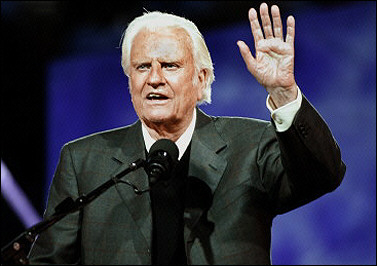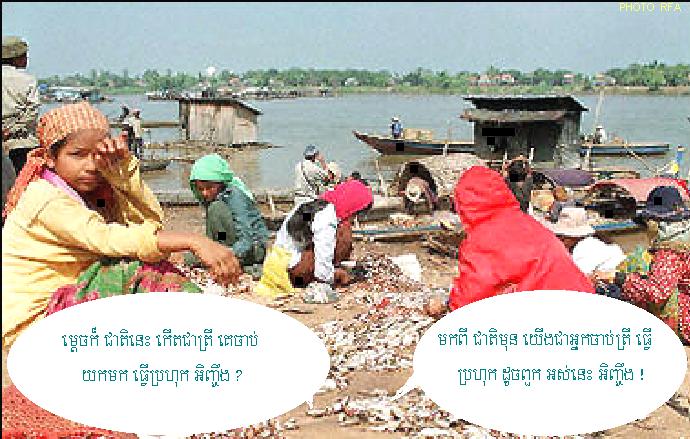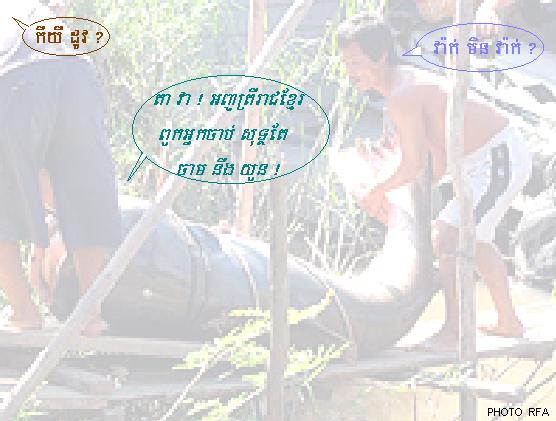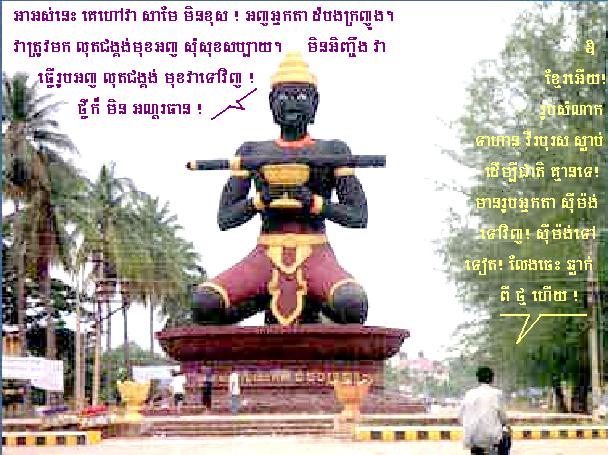RENCONTRER
DIEU |
DIEU
- VS - BOUDDHA
|
MEET
WITH GOD |
Idole en ciment
(2005-Jul-30)
Avant, sous Sihanouk, Lon Nol et Pol Pot, cette statue de l'esprit
DamBâng KrâNhoung (Bâton d'Ébène) n'existait
pas. Maintenant les touristes peuvent s'amuser de la vue de cette idole
en ciment (même pas en bronze pour ne pas prétendre à
la pierre d'Angkor!) au beau milieu de la route nationale No 5. Pour touristes
seulement? Il paraît que la population locale y vient brûler
des encens et prier pour obtenir de la paix, une guérison, de la
chance, de la protection, une vengeance....
|
|
Buddhism Spreads Down Under as Asians Change Australia (2005-Jul-02)
[ News Feature, Andrew Lam, Pacific News
Service
Editor's Note : Once oriented toward Europe,
Australia today describes itself as part of Asia, a change reflected in
many Australians' embrace of Buddhism, the second-largest religion in the
country. But tensions resulting from Asian immigration remain. ]
SYDNEY, Australia -- In West Sydney, the smoke one sees drifting over from
a neighbor's fence may not be the shrimp sizzling on the old barbie, but
drifting incense. Buddhism is rising fast here in the land Down Under,
and is now the second-largest religion after Christianity. Immigrants can
constitute up to half of the population in certain West Sydney districts.
Citywide, more than 50 temples dot the landscape, and in New South Wales,
Australia's most populous state, there are more than 150. They range from
the enormous Chinese Mingyue temple that sits on three acres to the tiny,
converted private residence that is now the Vietnamese Thien Hoa Nunnery.
Buddhism is changing a country whose compass had once steadfastly pointed
toward Europe.
In the posh Mingyue compound, which boasts a handful of the largest temples
in the southern hemisphere, the visitor gets the feeling of being in Beijing
or Taipei. Golden statues of Buddha and Bodhisattva line the walls, while
throngs of worshippers bow and chant in Chinese amid drifting incense.
In the Cambodian or Vietnamese temple, on the other hand, one is surrounded
by children's laughter and old folks cooking in the courtyard. It's typical
of immigrants' temples, doubling up as a place where children come to study,
do their homework, learn temple music, dance and speak their own language.
According to Cuong Le, an Asian Art expert for the Liverpool Powerhouse
Art Center, which will curate the exhibition "Buddha in Suburbia" for the
Fall 2006, there's a tour "mostly for Australians" that visits Buddhist
temples in West Sydney, because so many have sprung up so quickly there.
"I myself keep finding more temples, more variations, and the exhibition
is getting much bigger than I'd expected," Le says. Australia, once a homogenous
Western country founded by convicts sent from England in the late 18th
century, had traditionally kept its doors closed to immigrants from Asia.
But in the mid-1970s, the doors slowly opened to Asian immigrants as trade
with Asia increased. These days, the continent publicly describes itself
as "part of Asia." Asian immigrants now make up 10
percent of the population of 22 million. Asians are expected
to reach a quarter of the population in 2020. Buddhism is an inevitable
outcome of the demographic shift. Yet, not all is well in the country whose
favorite line is "No worries, mate!"
Fear of Asianization has caused some political leaders to have second thoughts
about Australian hospitality toward Asia, and hate crimes are not unknown
here. According to the documentary "Over the Fence," shown on public television
recently, Buddha is apparently not welcome in every suburb. Some neighbors
of a Cambodian Buddhist temple complained that the chanting was frightening
their horses. In another neighborhood, residents called the police because
the Buddhist chanting was too loud and the number of cars on weekends was
creating traffic in the small street. While the government is still committed
to cultural diversity, there's a growing backlash fueled by the fear that
multiculturalism will put an end to Australia's national identity. For
instance, Pauline Hanson, a one-time independent member of Australia's
parliament, vaulted into the international limelight by delivering anti-immigrant
diatribes. "I believe we are in danger of being swamped by Asians -- if
I can invite who I want into my home, then I should have the right to have
a say in who comes into my country," she once declared.
But for isolationists, perhaps it's too late. The influx of Asian has changed
Australia radically, and according to some, for the better. In a recent
article on Buddhism in Australia, art historian B.N. Goswamy, wrote: "The
number of distinguished Australians -- scholars, members of the business
community, bureaucrats -- who are not only drawn towards Buddhism, but
are practicing Buddhists, comes, at least to the outsiders, as a surprise."
Yet, Buddhism first came to Australia not through
recent Asian immigration but a via Dutch migrant named Leo Berkeley, who
came into contact with a Sri Lankan monk and was instructed into the Dharma
-- Buddhist teachings -- 50 years ago. Berkeley went on to found
the Buddhist Society of New South Wales, which continues to flourish today.
Cambodian monk Achang E, at Wat Khemarangsaram, says there's no real problem
with the temples' neighbors. "When we have big events, we go around the
neighborhood to ask permission and to ask them to join in. I find people
are generous and tolerant in general."
It also helps that non-Asians are converting en masse. John Brown, an artist,
has been a practitioner of feng shui and Buddhism for 15 years. "I love
everything about Buddhism. From ceremonies to the idea of enlightenment
to the idea of being compassionate to others and all living beings," he
says. Perhaps Buddhism, a traditionally non-proselytizing religion, is
thriving in places like Australia because it is, in many ways, compatible
with the needs of living in an increasingly global society. Barrie Unsworth,
former premier of New South Wales, once addressed the Buddhist community
thus: "As followers of [Buddha's] Path, you bring to your new life in New
South Wales that same spirit of tolerance and gentleness and kindness that
has continued through more than two and a half thousand years of your culture.
That spirit is entirely complementary to the path of multiculturalism that
I see as the future of this state."
But for Cuong Le, who hails from Vietnam and is himself a Buddhist, the
"Buddha In Suburbia" exhibition has proved anything but calming. "It's
been exhausting trying to coordinate with all the monks and artists." Still,
Le has plans for something that seems obvious but potentially explosive
as a follow-up exhibit -- the influence of Asian culture on Australia.
"We'll call it 'All Things Asians Are Becoming Us.'" Andrew Lam is a PNS
editor and the author of "Perfume Dreams: Reflections on the Vietnamese
Diaspora," forthcoming from Heyday Books this fall.
[Soc.Culture.Cambodia]
Billy Graham in New York
(2005-Jun-27)
NEW YORK (AP) - With all the talk about whether this weekend
would be the Rev. Billy Graham's final American revival, the 86-year-old
evangelist spoke strongly and clearly in the scorching summer heat Sunday,
flubbing only once when he said the D-Day invasion was in 1945, not 1944.
However, Graham's sermons each day were noticeably short. He spoke for
only 23 minutes Sunday before his energy appeared to flag and he abruptly
issued the invitation for people to come to Jesus.
For many of the 90,000 people in the audience, this was a sign. "It's
a little bit sad if this is the last one," said usher Bertha Astor.
The expectation this would be Graham's last revival meeting hovered over
the event all weekend. His sermon Sunday appealing for decisions to follow
Jesus emphasized that nobody knows the hour of death. Noting his own advanced
age, he said, "I know it won't be long."
|
 Photo AFP
Photo AFP |
"We are celebrating the end of 60 years of ministry
with Billy Graham," said the Rev. A. R. Bernard, crusade
chairman and pastor of Brooklyn's booming Christian Cultural Center. But
Graham seemed to toy with the crowd over the question, saying he hopes
"to come back again someday" and that he previously told journalists
who asked if this was the last Graham crusade, "never
say never." Graham is suffering from fluid on the brain, prostate
cancer and Parkinson's disease. He uses a walker due to a pelvic fracture
and is largely confined to his home in Montreat, N.C.
The man known as America's pastor is considering a request to hold a rally
in November in London, but Graham says chances are slim that he'll accept.
His son, the Rev. Franklin Graham, said the elder Graham does not like
to be away from his wife, Ruth, who is also in ill health. But an Anglican
rector from London was present in New York to coax Graham into visiting.
Out in the throng Sunday, Ismael Rivera, a New York City firefighter, didn't
want to believe it was the end. "Hopefully, praise God, I'm sure he
will go on." Joe Lin, a graduate student from Singapore, said he wanted
to see Graham preach one last time. "This is a historic moment,"
he said. "Nobody has had such impact on the people."
Graham waited to go on in an air-conditioned tent, with aides nearby in
case of a medical emergency and the stage shaded by a massive canopy. His
pulpit had a movable seat hidden from view, so he could sit down if he
felt unsteady. The total turnout for the three New York meetings was 230,000,
Graham's staff estimated, with 5,582 registering Christian commitments
the first two nights. Sunday's total of inquirers was to be announced later.
Sociologist William Martin, Graham's biographer, traveled from Rice University
to witness the revival. He said he expected to see a largely white turnout
but was struck by the diverse crowd. "I wonder if a crowd this large
and this diverse has ever assembled," he said. Martin recalled that
in 1953, Graham ended racially segregated seating at his crusades in the
South, even before the Supreme Court's school integration ruling. "There
he took the ropes down. And now all the barriers seem to be down,"
he said.
The program was hosted by Cliff Barrows, 82, and mixed contemporary Christian
bands with a nostalgic "How Great Thou Art" sung by George Beverly
Shea, 96. Barrows and Shea have appeared continually at Graham's meetings
for decades. Graham called his colleagues up for a round of applause and
said he's grateful "they put up with me. Sixty years we've been together."
Graham has preached to more than 210 million people in 185 countries.
He has been sought out for counsel and friendship by U.S. presidents and
leaders worldwide and, more than any other religious figure, has come to
represent the American evangelical movement.
Appearing at the Saturday night rally, former President Bill Clinton called
the evangelist the only person he has known who has always lived according
to his faith. "God bless you friend," Clinton said. "Bless you."
© 2005 Omaha World-Herald
Humour : Past, Present and Future Lifes (2005-Jun-19)

A fish : Why are we born
fish and being caught to be made Prahok paste ?
Another fish : Because in
our past life we were fish catchers and Prahok paste makers
like these people !
|
The giant catfish :
Holy Sushi ! I'm a Khmer
giant catfish. The fishermen
are all Cham and Yuon !
|

|
GOD
vs BUDDHA
( PRÉCÉDENT )
|
camboDIATRIBE
|
COURRI@L
2005
|
AUTRES
SITES KHMERS
|
KUN
PIMOJ 's HOMEPAGE
|
PHN@M-P@NH-P@TINS
|
FRAN-GLO-GIBWÉ
|
CANADA
3 FOUNDERS
|
MES
EMAILS 2003
|
THE
6 COMMANDMENTS
|
MEET
WITH GOD
|
PEN Nearovi, Montréal, Québec, Canada
(nearovi@sympatico.ca)



